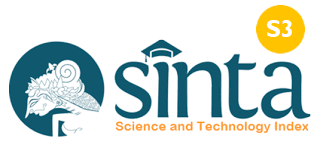Penerapan Metode Demonstrasi Mencampur Warna Untuk Meningkatkan Kemampuan Kognitif Pada Anak Didik Kelompok B1 Semester I Di TK Widya Kumara Duda Selat Karangasem
Keywords:
Cognitive, Method of Demonstration, Mixing Colors.Abstract
The ability and activity of children in mixing colors at the initial condition is still very low. Classroom action research was conducted to improve cognitive ability to recognize colors, namely aspects of pointing colors, calling colors and mixing colors. The subjects of the study were 20 people in the group B1 TK Widya Kumara Selat Duda. This study aims to describe the implementation of the demonstration method and the results of learning to recognize colors, designed in two cycles consisting of planning, implementation, observation/assessment and reflection stages. Data were collected by observing the ability of children's learning outcomes and analyzed by qualitative descriptive analysis. The indicator of the average success of learning outcomes is in category B (Good). Based on the learning outcomes from pre-cycle 15% improvement in learning outcomes in cycle I showed that there was an increase in cognitive ability to recognize colors from 20% to 50% and in cycle II there was an increase in cognitive ability to recognize. Thus, it was concluded that the application of the demonstration method was able to improve the cognitive ability to recognize the color of the students of group B1 TK Widya Kumara Selat Duda Karangasem.
References
Aqib Zainal, dkk. (2016). Kumpulan Metode Pembelajaran Kreatif & Inovatif. Bandung : Penerbit Satunusa
Asmawati Luluk, dkk. (2011). Pengelolaan Kegiatan Pengembangan Anak Usia Dini :Jakarta : Universitas Terbuka
Choir Risa. (2015). Pemantapan Kemampuan Profesional Penerapan metode Demonstrasi Mampu Meningkatkan Kemampuan Konitif di TK Aisyah Banjar Lebah Klungkung.
Departemen Pendidikan Nasional. (2012). petunjuk Teknis Penyelenggara Taman Kanak-Kanak : Jakarta
Departemen Pendidikan Nasional. (2014). Peraturan Menteri Pendidikan danKebudayaan Rebublik Indonesia. Jakarta : Direktorat Jenderal Manajemen Pendidikan Dasar dan Menengah
Rusmini, N. K. (2015). Pemantapan Kemampuan Profesional Upaya meningkatkan Kemampuan Kognitif Melalui Metode Demonstrasi Mencampur Warna Pada Anak TK Widya Kumara Pura Sebudi.
Departemen Pendidikan Nasional. (2014). Peraturan Menteri Pendidikan dan Kebudayaan Rebublik Indonesia. Jakarta : Direktorat Jenderal Pendidikan Anak Usia Dini
Dhieni, Nurbiana dkk. (2007). Metode Pengembangan Bahasa.Jakarta : Universitas Terbuka
Gunarti Winda dkk. (2015). Metode Pengembnagan Prilaku dan Kemampuan Dasar Anak Usia Dini. Tanggerang Selatan : Universitas Terbuka
Hitimah, I. (2000). Strategi dan Metode Pembelajaran. Bandung : Adira
Majid, A. (2005). Perencanan Pembelajaran : Mengembangkan Standar Kompetensi Guru. Bandung : PT. Remaja Rosdakarya.
Pekerti, Widia, dkk. (2012). Metode Pengembangan Seni. Tanggerang Selatan : Universitas Terbuka.
Sagala, S. (2003). Konsep dan Makna Pembelajaran :Untuk Memecahkan Problematika Belajar dan Mengajar. Bandung : Alfabeta
Sujiono, Y. N. (2014). Metode Penembangan Kognitif. Tanggerang Selatan : Universitas Terbuka
Surakhmad, W. (1979). Metodologi Pengajaran Nasiona. Bandung : Jemmars
Wardhani, IGAK. (2014). Penelitian Tindakan Kelas.Tanggerang Selatan : Universitas Terbuka.
Downloads
Published
How to Cite
Issue
Section
License
An author who publishes in the Cetta : Jurnal Ilmu Pendidikan agrees to the following terms:
- Author retains the copyright and grants the journal the right of first publication of the work simultaneously licensed under the Creative Commons Attribution-ShareAlike 4.0 License that allows others to share the work with an acknowledgement of the work's authorship and initial publication in this journal
- Author is able to enter into separate, additional contractual arrangements for the non-exclusive distribution of the journal's published version of the work (e.g., post it to an institutional repository or publish it in a book) with the acknowledgement of its initial publication in this journal.
- Author is permitted and encouraged to post his/her work online (e.g., in institutional repositories or on their website) prior to and during the submission process, as it can lead to productive exchanges, as well as earlier and greater citation of the published work (See The Effect of Open Access).
Read more about the Creative Commons Attribution-ShareAlike 4.0 Licence here: https://creativecommons.org/licenses/by-sa/4.0/.





